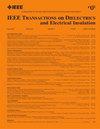基于单壁碳纳米管的介电弹性体自清除电极概念
IF 3.1
3区 工程技术
Q2 ENGINEERING, ELECTRICAL & ELECTRONIC
IEEE Transactions on Dielectrics and Electrical Insulation
Pub Date : 2025-01-15
DOI:10.1109/TDEI.2025.3530384
引用次数: 0
摘要
对于由电活性聚合物(EAP)材料制成的电子元件,柔性电极之间的击穿是失效的主要原因。与高压电容器类似,需要一个自清除机制来最小化单个缺陷导致完全失效的可能性。为了满足顺应性和自清洁的需要,单壁碳纳米管(SWCNT)薄膜得到了广泛的应用。然而,制造大面积swcnts薄膜的复杂和昂贵的工艺阻碍了其在工业上的应用。为了减少碳纳米管的使用,同时保持自清除性能,本文提出了一种新型的可拉伸自清除电极结构,该结构使用由碳纳米管线连接的炭黑(CB)组成的图图化电极。建立了一个标准,成功的自清除过程的swcnts线电极。研究了影响自净性能的几个关键因素。高击穿电压和细窄的swcnts线电极有利于自清除成功率的提高。除了自清除性能外,还研究了CB图案的大小和数目对电容保持的影响。在自清除事件之后,电介质的部分有源区域丢失。目标是在自清除事件后最大限度地保持电容,实验和理论分析了这一点。最后,提出了如何选择图像化CB的数量和面积,使电极面积得到最佳利用。本研究为碳基自清除电极的进一步量产提供了理论和实验基础。本文章由计算机程序翻译,如有差异,请以英文原文为准。
A Self-Clearing Electrode Concept for Dielectric Elastomer Applications Using Single-Wall Carbon Nanotubes Line
For the electronic components made of electroactive polymer (EAP) materials, a breakdown between the compliant electrodes is the main cause of failure. Similar to high-voltage capacitors, a self-clearing mechanism is needed to minimize the probability of a single defect leading to complete failure. In order to meet compliance and self-clearing needs, single-wall carbon nanotube (SWCNT) films are widely used. However, the complex and expensive process of manufacturing of large-area SWCNT film hinders its application in industry. To reduce the usage of SWCNT while maintaining self-clearing properties, a novel stretchable and self-clearing electrode configuration is proposed in this article, using a patterned electrode consisting of carbon black (CB) connected by SWCNT line. A criterion was established for a successful self-clearing process of the SWCNT line electrode. Some key factors affecting the self-clearing properties were investigated. It was found that high breakdown voltage and thin and narrow SWCNT line electrodes are beneficial to the self-clearing success rate. Besides the self-clearing properties, the effect of the size and number of the CB patterns on capacitance retention was studied. After a self-clearing event, part of the active area of the dielectric is lost. The objective is to maximize capacitance retention after a self-clearing event, which was analyzed experimentally and theoretically. Finally, it is suggested how to select the number and area of the patterned CB, making optimal use of the electrode area. This study provides a theoretical and experimental basis for further mass production of carbon-based self-clearing electrodes.
求助全文
通过发布文献求助,成功后即可免费获取论文全文。
去求助
来源期刊
CiteScore
6.00
自引率
22.60%
发文量
309
审稿时长
5.2 months
期刊介绍:
Topics that are concerned with dielectric phenomena and measurements, with development and characterization of gaseous, vacuum, liquid and solid electrical insulating materials and systems; and with utilization of these materials in circuits and systems under condition of use.

 求助内容:
求助内容: 应助结果提醒方式:
应助结果提醒方式:


